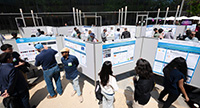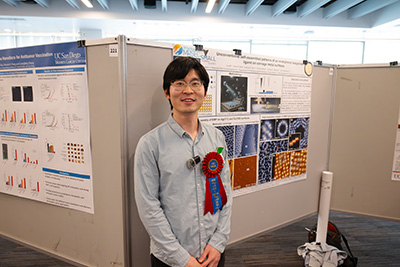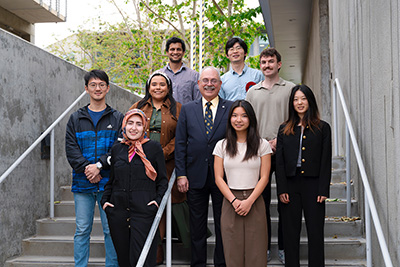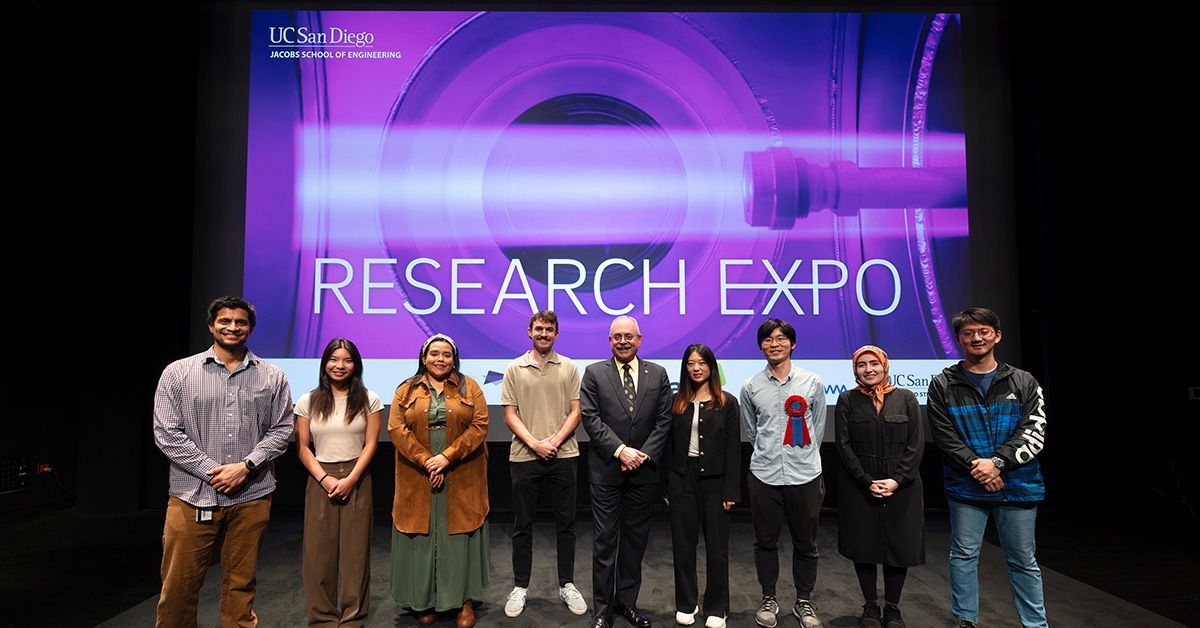Self-assembling Molecules Take the Spotlight at Research Expo 2025
Story by:
Published Date
Article Content
University of California San Diego materials science and engineering Ph.D. student Liya Bi won the grand prize at the 43rd annual Jacobs School of Engineering Research Expo for his work studying how molecules organize themselves into highly ordered patterns on metal surfaces—patterns that may one day influence the development of advanced materials and transform the way microchips are manufactured.
Selected from among more than 160 graduate student presenters from all six Jacobs School of Engineering departments, Bi impressed a panel of judges not only with the technical rigor of his research, but also with his ability to clearly explain its impact and significance to a non-technical audience.
Each year, Research Expo brings together alumni, industry partners and faculty to connect, collaborate and meet top-tier graduate student researchers. The event provides students an invaluable opportunity to practice communicating the broader significance of their work to an interdisciplinary audience, and to collaborate with peers outside their field to help translate that work into accessible, compelling presentations. More than 110 judges participated this year; most judges are industry professionals, many of whom are also alumni or members of the Jacobs School’s Corporate Affiliates Program (CAP).

“The Jacobs School is here to fulfill its mission to advance engineering and computer science for the public good—and we must collaborate to do that to the fullest,” said Albert P. Pisano, Dean of the Jacobs School of Engineering and Special Adviser to the Chancellor. “The days are long over when one person has one idea and works by themselves towards a solution. That’s why I strongly believe in the following mantra: the great engineering schools of the next decade will collaborate their way to relevance. That’s the mantra that we live by here at the Jacobs School.”
In his remarks, Pisano thanked the Research Expo premier sponsors Leidos, Viasat; partner sponsor Qualcomm; contributor sponsor UC San Diego Extended Studies; and all member companies of the Jacobs School’s Corporate Affiliates Program.
In addition to the $1,500 grand prize, called the Lea Rudee Outstanding Poster Award, judges selected one student presenter from each of the Jacobs School’s six academic departments to receive a $750 Department Best Poster Award. Attendees also voted to name the recipient of the $500 People’s Choice Award.
The final award of the evening, called the Transdisciplinary Collaboration Award, came with a $1,000 prize and honored a unique student partnership: the winning pair consisted of one engineering graduate student and one non-engineering student who worked together in the weeks leading up to Research Expo to craft an oral presentation and poster that made complex research more accessible to a general audience. The award was funded by Jacobs School alumni and Research Expo judges Sam Knight and True Xiong. In advance of Research Expo, alumni run a workshop where student presenters can practice bridging the communication gap between technical research and public understanding. This year, at the workshop, Knight and Xiong were joined by Jacobs School alumni Silvia De Dea and Karcher Morris.
All award recipients are listed below.

Exploring how molecules assemble into exotic patterns on metal surfaces
Using high-resolution microscopy, Bi takes a close look at how a particular family of molecules, called m-terphenyl isocyanides, spontaneously assemble into ordered structures on silver and copper surfaces. Rather than forming the regular grids or simple clusters found in many other molecular systems, m-terphenyl isocyanide molecules, Bi discovered, organize into unconventional and more complex arrangements including rings, ribbons, hexagons and tightly packed monolayers that resemble the weave of a knitted fabric.
“These patterns are highly uncommon and have rarely been reported in the literature,” said Bi, a Ph.D. candidate working in the lab of UC San Diego chemistry and biochemistry professor Shaowei Li. “This discovery tells us that this class of molecule has a unique self-assembling behavior, which is attracting scientific attention. Our goal now is to control this behavior, so we can ultimately harness it for practical applications.”
The findings, he said, are inspiring him and his colleagues to explore ways to fine-tune and control the molecules’ behavior by making small chemical modifications—for example, replacing specific atoms or adding different chemical groups to the molecular structure. These modifications are expected to alter how the molecules interact with both the surfaces and each other, which could potentially lead to the formation of new self-assembled patterns. “We’re really curious to see how these chemical changes give us greater control,” Bi said. “It’s like having a set of tuning knobs that allow us to rationally design the building blocks and predict the types of structures the molecules are going to form. Essentially, we are programming them to construct the structures we want. That’s super exciting.”
The potential applications are just as exciting, Bi explained. One potential use is in microchip manufacturing. If researchers can reliably direct the self-assembly of molecules into specific patterns, they could use these molecular arrangements as templates to etch nanoscale features into electronic components. Another potential use is in the formation of self-assembled monolayers on reactive metal surfaces to provide a protective coating against corrosion.
For Bi, the driving force is something more fundamental: scientific curiosity.
“All these applications are grounded in a fundamental understanding of how these molecules self-assemble on surfaces,” Bi said. “With that understanding, we can begin to design and control the formation of new and complex patterns and structures tailored for specific purposes. This is the foundation of progress in science and technology. Without fundamental research like this, such applications simply wouldn’t be possible.”

2025 Research Expo award winners
Bioengineering—Shu and K.C. Chien Best Poster
“Visualizing protein communication in human cells to improve cancer treatment”
Student: Rosie Zhou
Advisor: Jin Zhang
Chemical and Nano Engineering Best Poster
“Exotic self-assembly of m-terphenyl isocyanide ligands on silver surface”
Student: Liya Bi
Advisor: Shaowei Li
Computer Science and Engineering Best Poster
“WLB-LLM: Workload-balanced 4D parallelism for large language model training”
Student: Zheng Wang
Advisor: Yufei Ding
Electrical and Computer Engineering Best Poster
“PaciForce: A pacifier-embedded sensor for precision breastfeeding assessment”
Students: Ishan Bansal and Nagarjun Bhat
Advisor: Dinesh Bharadia
Mechanical and Aerospace Engineering—Katie Osterday Best Poster
“Facet engineering in tantalum carbide nanoparticles via transition metal doping”
Student: Stephanie Ortega
Advisor: Olivia Graeve
Structural Engineering Best Poster
“Motion tape wearable sensors for physical therapy, rehab and training”
Student: Elijah Wyckoff
Advisor: Ken Loh
People’s Choice Award
“Optical barcoding for multi-stain 3D histology reconstruction”
Student: Zerlina Lai
Advisor: Yonatan Winetraub
Transdisciplinary Collaboration Award
“Quantifying the dynamic interplay of autophagy, vacuolar function and longevity in yeast”
Students: Zahra Karimi and Srinivas Ravishankar
Advisor: Jeff Hasty
Share This:
You May Also Like
Stay in the Know
Keep up with all the latest from UC San Diego. Subscribe to the newsletter today.




